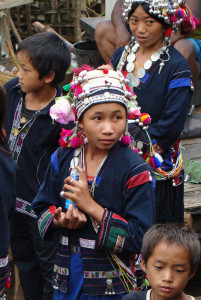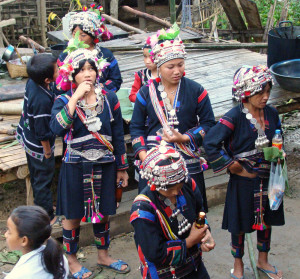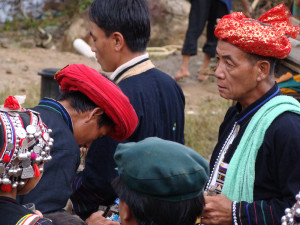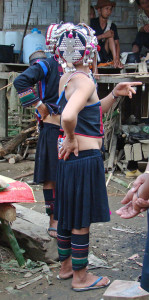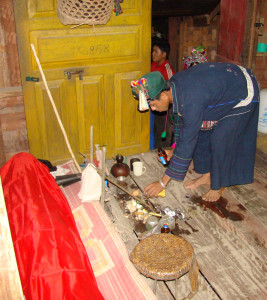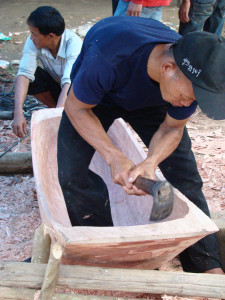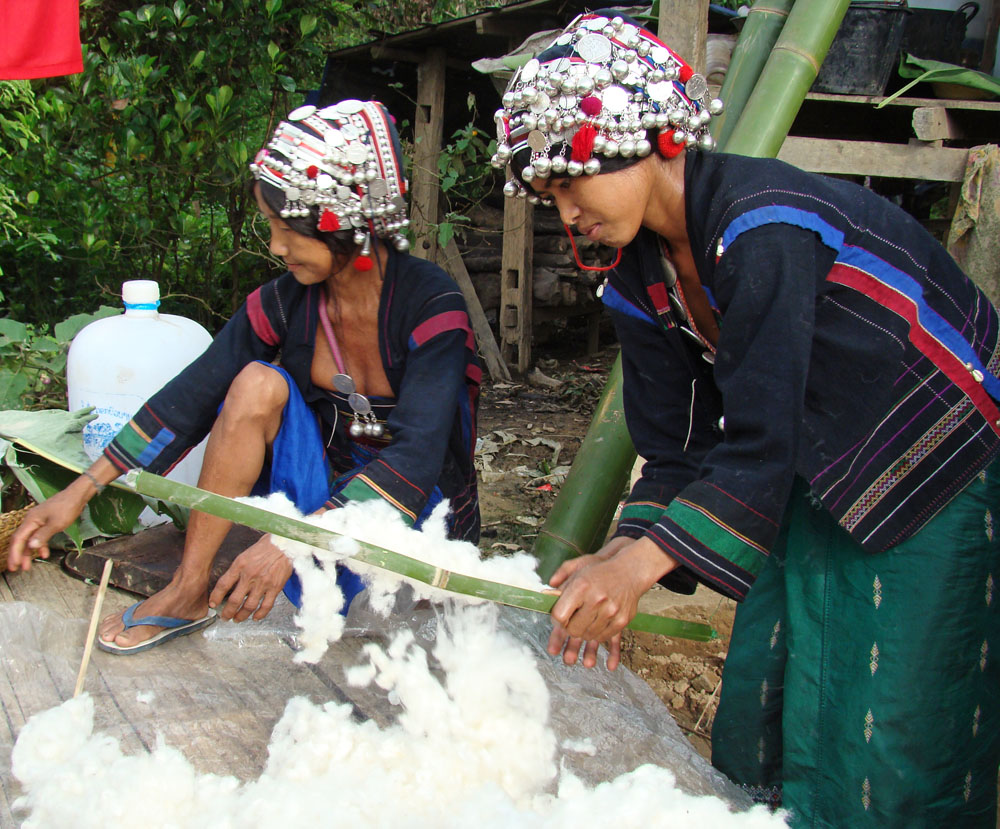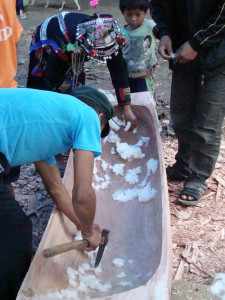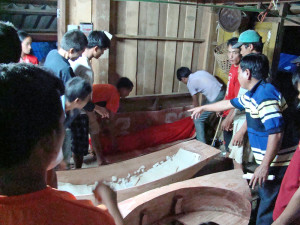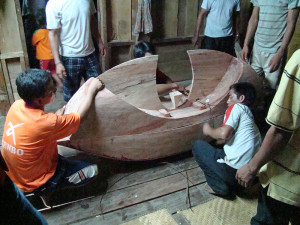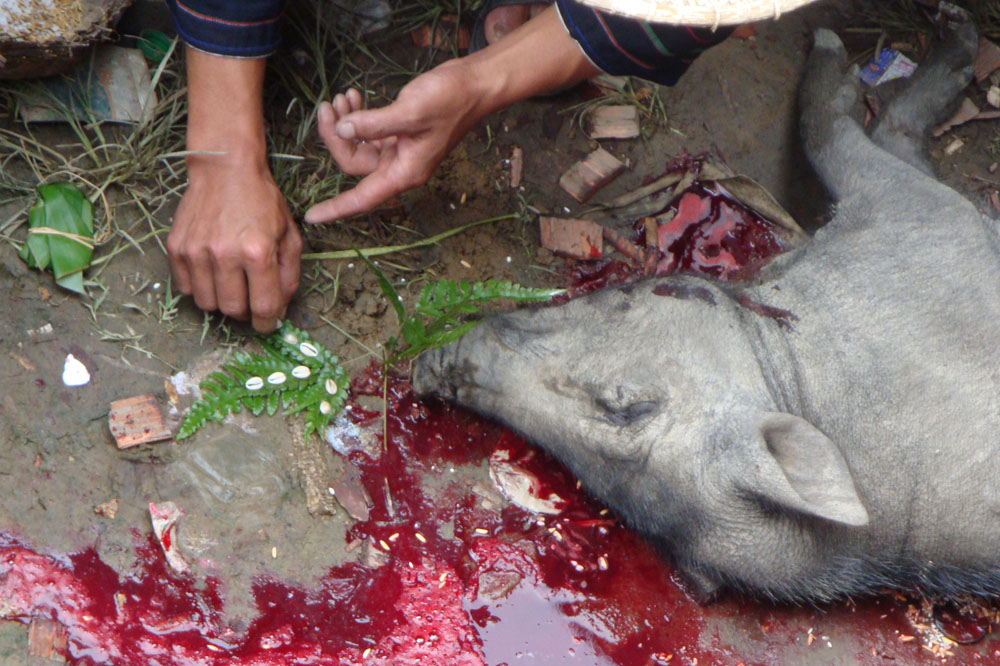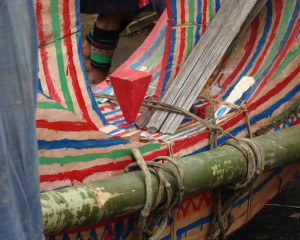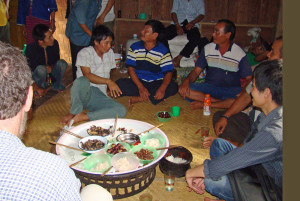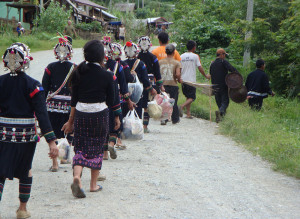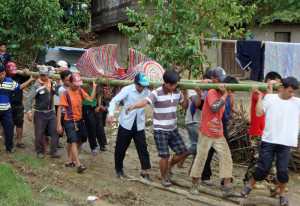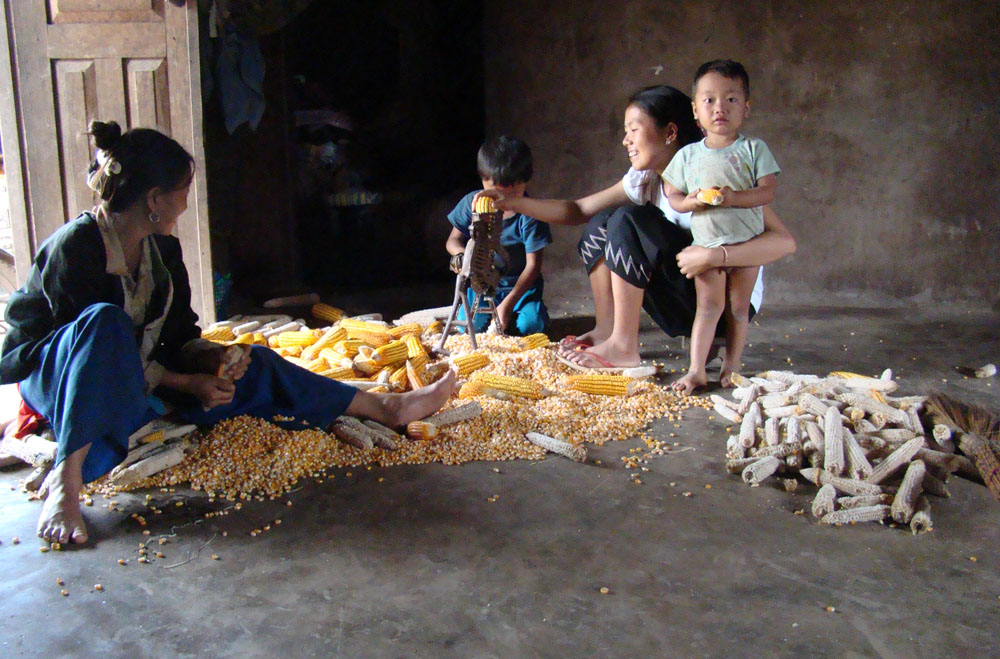An Akha Funeral
The Akha were originally a Tibeto-Burmese minority group who, in order to escape persecution in the 19th century, migrated south into southern China, Myanmar (Burma), Laos, Thailand, and Vietnam. Most are subsistence farmers who, by virtue of being late migrators, live in the more hilly, less accessible, and hence poorer parts of the region. There are 1-2 million Akha people divided into many “sub-groups” (classification techniques vary); 60,000 live in NW Laos. Traditionally they are animists, believing in ancestor worship and the spirits of the forest. Traditional Akha villages have a spirit gate at each entrance through which people who stay in the village must pass – this keeps unwanted forest spirits in the forest. Their ancient history is oral, and preserved in 10,000 lines of poetry memorized by “Pimas”, the designated story-tellers of the Akha. Only recently has a written form of the language been created.
The Akha leadership struggles for recognition and support in their host nations; some seek autonomy. About one-fourth of the Akha people have been converted to Christianity, also creating concern among its leaders, as conversion to any other religion undermines Akha traditions and culture. Laos does not allow active missionary work.
Last month, our guide and friend in Muang Long in NW Laos, Tui Chaddala (see newsletter #6), again created an unusual and magical opportunity for us. We had told Tui that while we were on a “shopping” trip for authentic cultural items, any chance to see unique cultural events would be most welcome, whether business-related or not.
Next day, quite by chance, we arrived at an Akha village (Puli sub-group), Pha Home, on the third day after an important 75-year-old elder, Pha Home’s coffin-maker, had died. We had missed the first two days when the body is wrapped in black and red fabric, the extended family is called to join, and a team of young men is sent into the forest to cut down an appropriate tree for the coffin (the Akha have government permission in a nearby forest reserve for such needs). We stumbled upon the event on its third day, after family and friends were assembled, and just after a water buffalo had been roasted to feed everyone for the ceremony’s duration.
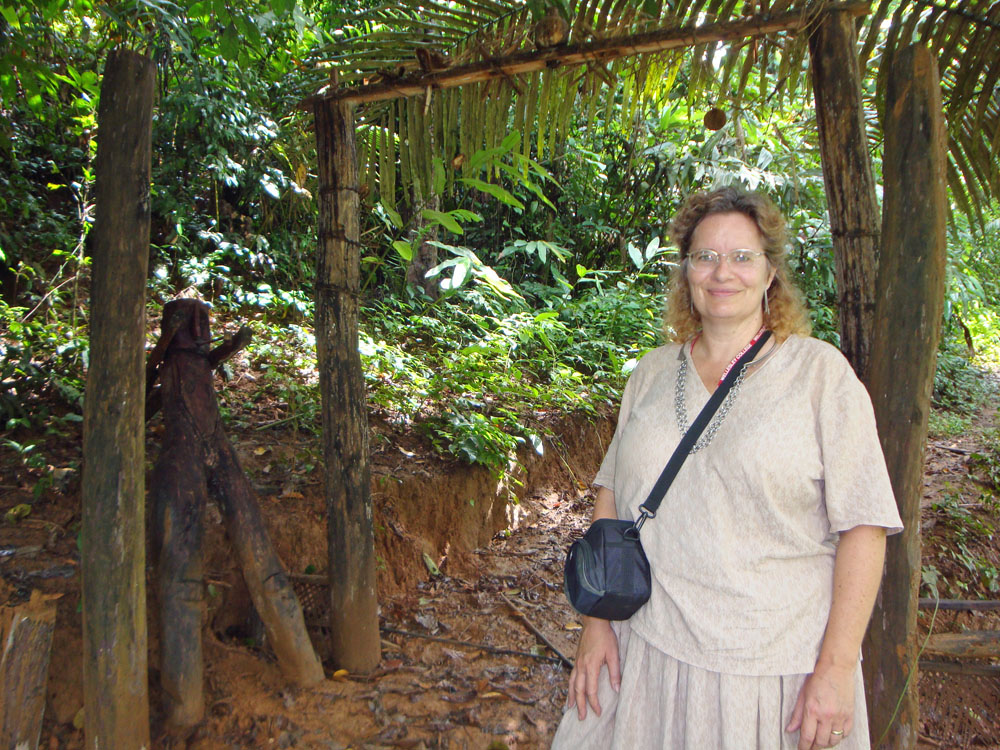
Maren in front of an Akha Spirit Gate with a human figure showing the people’s side of the gate, NW Laos.
Upon our arrival, Tui, who knows some Akha language, checked with the villagers who nodded that it was OK to go up to the mourner’s house; we assumed our presence might be inappropriate, especially given the Akha belief that spirits directly affect daily life. Maren took a few surreptitious photos of the colorful scene with her camera resting on top of the case and set on the no-flash, low-light setting. People were in full ceremonial regalia – Akha women in headdresses covered in silver ornaments, jackets with embroidery and more silver on the back, pleated low-slung skirts, and a trapezoid-shaped shirt, most often tied just under the breasts. In Akha culture, women’s breasts are not sexualized, and are often bared, particularly on older and nursing women. Men wore loose indigo-dyed cotton pants and jackets with silver buttons down the front, and some wore red headdresses wrapped many times around the head so as to make a brim about 3″ wide.
Tui discovered that one of the sons of the deceased, Mr. Champa, was an acquaintance of his, and Mr. Champa quietly said we could join the family’s funeral party that day. We were then offered the traditional 2 shots of lao-lao (distilled rice whisky) and cigarettes, which we dutifully smoked (cough, hack!) to shared laughter. Tui told Mr. Champa that it was Maren’s first cigarette, and she was smoking it in his father’s honor – he thought that was a hoot! Around us was a great deal of laughter and conversation. Younger men were playing cards and gambling on the patio under the stilt-raised house; dogs were running around sneaking bones and tidbits of fat; chickens were hunting for rice grains and anything they could beat the dogs to; kids were yelling, chasing, crying, and generally being kids.
After perhaps an hour, Mr. Champa invited us into the house and room where his father lay in state. The body was wrapped in red cloth, and an altar had been placed next to his head where people stopped to pray and chant and offer rice, meat, lao-lao, eggs, and other items in his honor and that he might need in his afterlife. We were invited to sit with the village chief and some other headmen of the village. A daughter-in-law of the deceased offered us each two more shots of lao-lao followed by a cup of water. Before drinking each shot, we poured a small amount into an old rusted tin can full of cigarette butts as an offering to the coffin-maker. Same with the water. That signified that we were officially a part of the funeral party. Mr. Champa then announced that we were welcome to take as many photos and videos as we’d like – a stunning opportunity that we never expected to receive. Being allowed to photograph any rite of passage, particularly an Akha funeral, is unheard of. We promptly set to work photographing everything possible.
An hour later we heard a hullabaloo, and all of the people, led by the young women, headed off to greet the cutters and shapers of the coffin just a short way into the woods. We followed, slipping on the muddy trail and eventually giving up all attempts to stay clean. We reached the coffin, which had been carried in two pieces, top and bottom, through the woods by strapping them onto long bamboo poles with rattan ties. The mourners each walked between the two coffin pieces, placing an offering of a paste of rice and spices onto the crude coffin halves. This cleansed the coffin of forest spirits who may have followed the coffin back to the village. Then, with a shaman chanting throughout, the relatives offered lao-lao and cigarettes to the dozen-plus men who had gone to the forest to cut the tree and roughly form the coffin. There were probably about 150 people all told in a tiny clearing made by chopping down some bushes – the ants that lived there were not pleased, and climbed up legs and bit when possible. As non-locals, we were strictly forbidden from touching the coffin as we might have introduced foreign spirits into the scene requiring deeper cleansing – who knows what might have happened then! We followed the coffin and the line of ululating mourners through the forest back to to the roadside village, and, with night falling, returned to our guesthouse in nearby Muang Long.
The next morning we visited two other 200-300 person villages, slipping on the trails after each monsoon rain burst. Maren had a particularly exciting “pirouette” and spent the rest of the day with a mud-decorated skirt. However, our minds kept returning to Pha Home and the opportunity to immerse ourselves in what seemed like a “National Geographic” moment.
We talked to Tui and said that, given Mr. Champa’s blessing to film the rare event, we would rather see the funeral than to go trekking, as planned, to another village; the funeral was something we would probably never get a chance to see again. So in the afternoon, we returned to Pha Home. Mr. Champa smiled broadly and raised his hands in the traditional Lao “sabaidee.” We were welcomed with more lao-lao and cigarettes – Maren gently refused the cigarettes this time. All afternoon we studied a team of about 15 men who trimmed and smoothed the coffin until it was as thin as possible. They even used an electric planer (!) to assure a quality finish. The finished coffin is a striking artifact, with it’s boat-shaped bottom, and eerily out-of-this-world wooden flanges that reminded us of sails. Meanwhile, a different type of wood was carved into two “feet” to hold the coffin upright, and a man thinned and smoothed long rattan strips to hold the coffin closed. Off to the side, Akha women were using a bow to fluff fresh cotton to use to line the wooden coffin for the deceased’s comfort. After the coffin was shaped, each relative took a handful of fluffed cotton and stabbed it with a machete or other tool into the inside, both top and bottom, of the coffin until the cotton stuck.
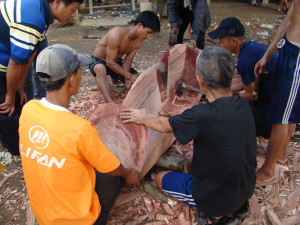
The coffin is trimmed using hand and electric tools to create the best shape as befits a coffin maker’s final resting place,
We were then motioned upstairs. Maren managed to squeeze into the room, but Josh and Tui didn’t make it in as the room was so crowded. Maren videotaped the entire process of moving the body into the coffin amidst a constant and loud discussion that appeared to be about how to do it correctly. It seemed that for each talker there were two opinions! First the cousins and important friends and villagers placed small (about 12″ x 8″) pieces of handspun handwoven cotton cloth on the bottom of the coffin. Then, the body was lifted in on the mat it was laying on. (In the heat and humidity, it was clear why the body must be placed in the coffin on the 4th day.) The red cloth was pulled back from the head, the black fabric wrapping the body was opened just enough to see the forehead, and then the cousins, shaman, etc., touched the forehead with cotton pieces (we later learned they were ritually wiping away “tears” from the deceased’s eyes) they then placed on his chest. The head was then rewrapped, the red cloth put over again, then more white cotton fabric placed over the body. His mattress cover (minus the filling) was used to help tuck him gently in, and then the top of the coffin was put in place.
Women were chanting and ululating in the corner of the room while his body was placed in the coffin. Suddenly, there was a piercing scream and a richly adorned woman collapsed in the corner and had to be carried out of the house on the back of a man. What we had assumed was a family member overcome by grief turned out to be a woman shaman whose head was accidentally touched by a mourner in the crowd. The Akha believe that the head is a sacred part of the body and it shouldn’t be touched by others. The shaman was whisked away followed by a dozen women and men (and the usual gaggle of children) to have her face and head cleansed. Darkness had fallen as they were sealing the cracks between the two coffin pieces and painting bright decorations on the rich wood coffin; it was time for us to return to our guesthouse.
The next morning Mr. Champa invited us again up to the room with the body in state. The coffin had now been painted with stripes and zig-zag patterns using store-bought acrylic paint in red, blue, and green. A bright red pyramid, perhaps 8” tall and representing the coffin-makers heart, was placed upside-down in the center of the coffin’s lid. A shard of wood made from the same tree-type of his pre-deceased wife’s coffin was wedged between the rattan ties and the coffin; this assured that the two would be together in the next world.
After sharing a modest meal of the water buffalo, fried pork, and rice, Mr. Champa proceeded to tell us he was very grateful for our being there to document the funeral. Most funerals now do not have a traditional coffin due to cost and the rarity of the right types of trees. He said that not only would he have photos for himself and the family of the event, but now, any Akha who did not know how to conduct a traditional funeral could come and look at the photos and video to learn how to do so. He said that no one at the funeral knew of another funeral where falang (westerners) had attended. We, of course, expressed how honored we were to both witness and photograph the funeral; we would always remember them and the funeral as a special and rare opportunity to see a slice of real Akha tradition. Mr. Champa said that his father had never been outside of Laos in his life, but now, with our photos being taken home, his father’s spirit would be able to travel to see America. Everyone thought that was a wonderful thing!
Then another hullabaloo arose outside. A pig was being ritually slaughtered. The squealing pig was held in place while the shaman directed the oldest son of the deceased where to stick the pig. A piece of banana leaf was held between the pig and the knife, then the son quickly shoved the knife in and the pig bled out. A hole was then dug in front of the pig’s nose and several fern fronds were woven together in a specific design, with cowry shells laid in lines along the stem of the bottom-most fern. At this point the entire courtyard went silent.
The eldest son repeated after the shaman for all the locals to hear the names of the 57 consecutive ancestors of the coffin-maker and then the name of his father. This was the first time the coffin-maker’s name was included in the list of ancestors. A bowl of rice and salt was poured over the pigs nose, and the ceremony concluded. The pig was quickly gutted, seared, cooked over an open flame and distributed in small pieces to all the villagers not related to the deceased. The relatives were not allowed to eat any of this pig at all. Meanwhile, while the pig sizzled on the fire and the young people returned to gambling games and laughter, the youngest son sat quietly in place, alone, clearly mourning.
After the pig was cleared away, everyone came down from the house, two bamboo poles were tied together with large sturdy lengths of rattan, the coffin was brought down from the house (amidst a thousand loud directives), and the procession took off for the cemetery complete with bags of the dead man’s possession: clothes, rattan chair, hat, basket, machete, etc. We were not allowed to go to the cemetery unless we were committed to follow the tradition of the mourners who were required for the next 6 days to remain inside the elder’s home eating only rice, salt, and water. About 370 photos and 25 videos later, our experience was done. Mr. Champa was most grateful for a DVD of all the festivities, and we felt ecstatic to have witnessed this rare event. We are deeply grateful to Mr. Champa, Tui, and the entire community of Pha Home for inviting us to join in this unique and powerful experience.
The next day we visited 3 other villages. The first was a Hmong village where a 5-year-old girl had died. We were, again, welcomed by the village members into the mourner’s room. The drummer nodded and bowed at our entrance, missing only a single beat, and then returned to his task. The body lay on a platform against the far wall about 4 feet above the ground. A person in the dark room set out a wooden chair for each of us to sit front and center. This funeral was hard; no one was gambling or celebrating or preparing colorful rituals. There was only the soft shaman’s chanting, a constant drum beat, the eerie drone of a kaen (reed organ), and the crying pleas of the family who repeatedly touched the small body and then held there hands in front of themselves as if asking “Why?” In the dark and humid hut, our eyes welled up. The pain was exposed and raw, unjust and cruel. Again, however, the community was present, talking, playing music, shucking corn, and being a community together. All present – parents, villagers, and even this couple of wandering falang – were invited to mourn and feel the deep and profound loss and the power of what we cannot control or understand.
The contrasting funerals gave us pause. In one home death was celebrated in full regalia, and in another it was mourned in deep grief. Such festivity and beauty; such pain and fragility. The warm glow of long-burning coals; the quick extinguishing of a bright spark. The mystery of death and life was exposed; the earth accepts us regardless of age or status. That is what we surely share; that is the proof that we are all one human family.

